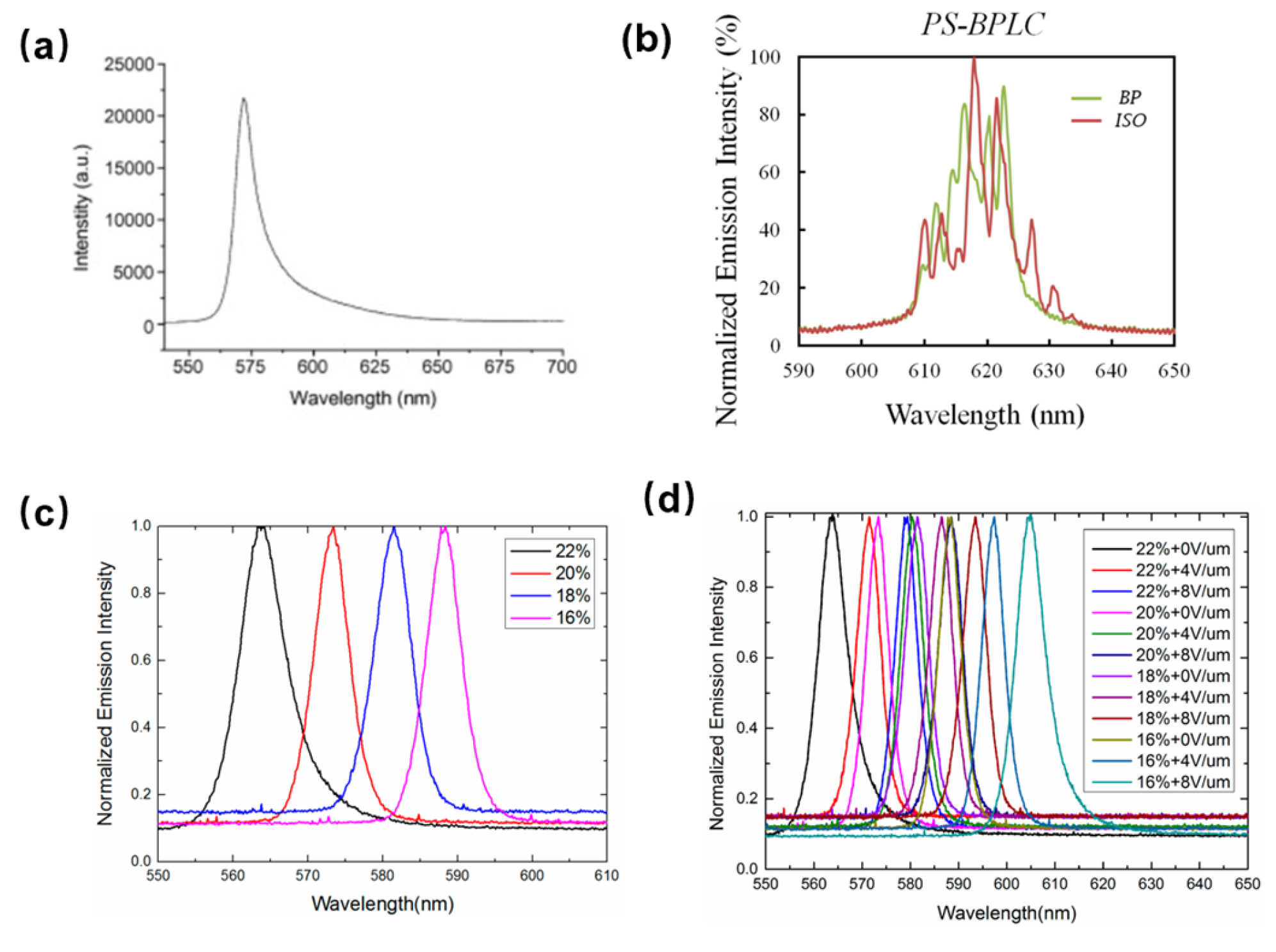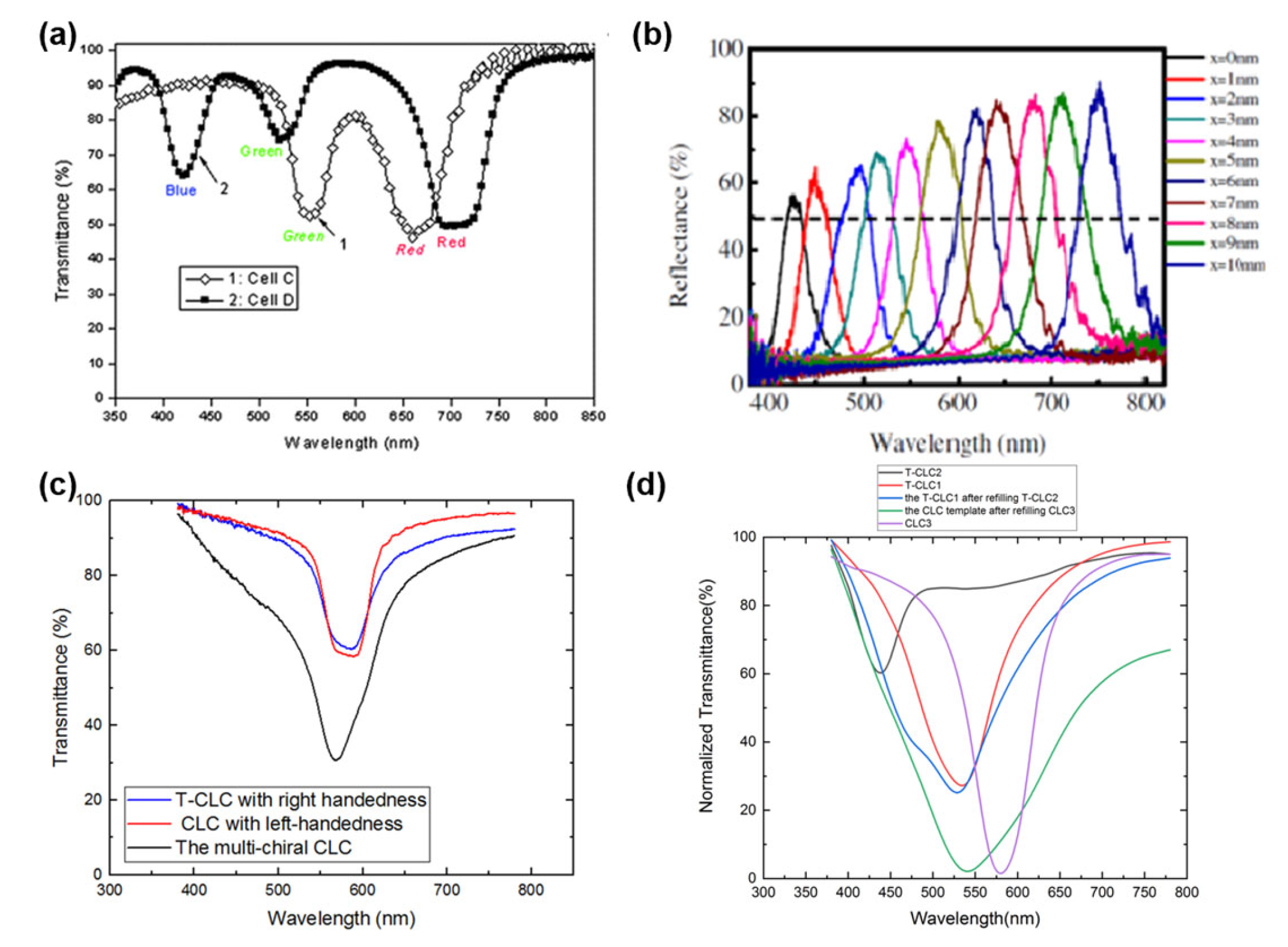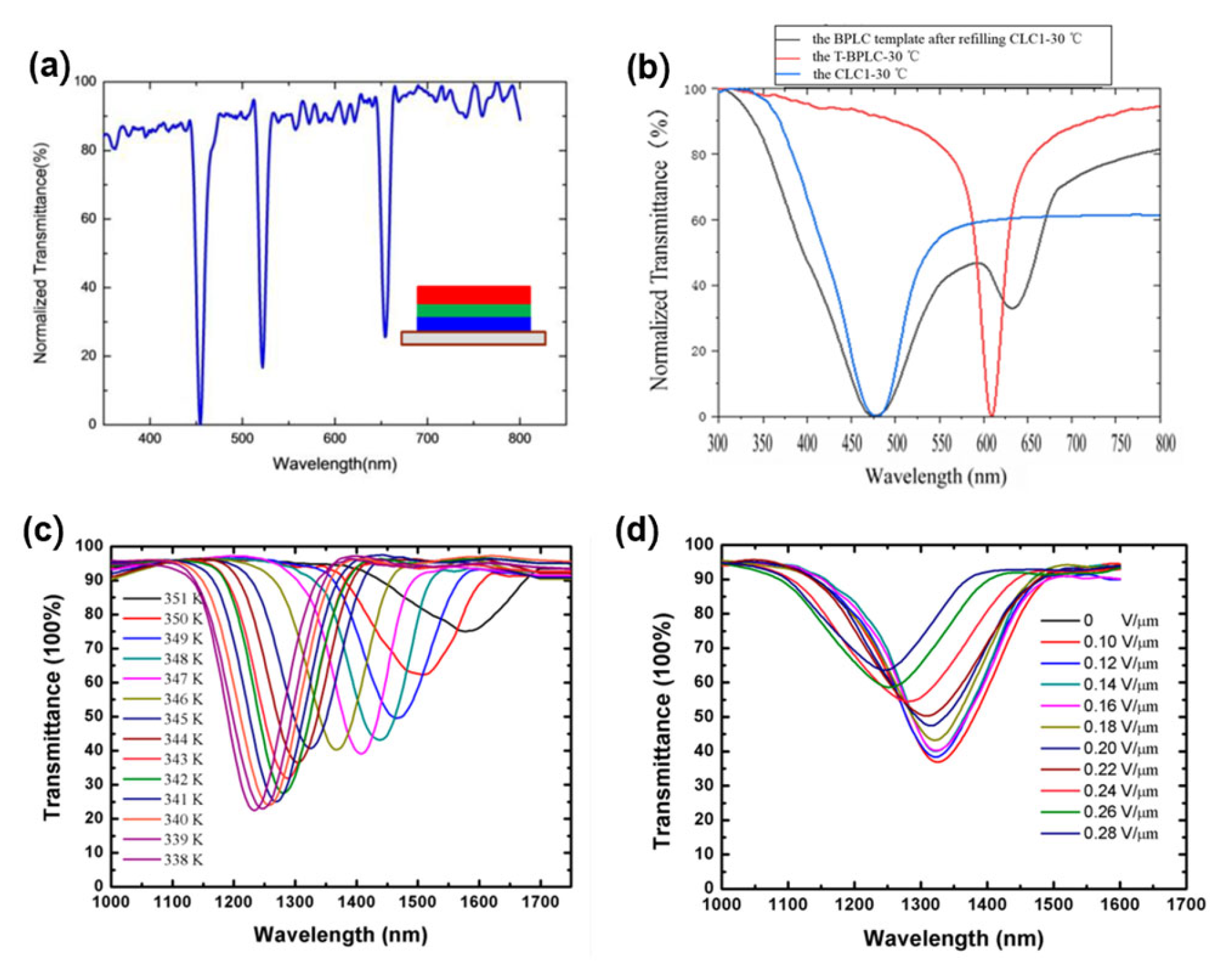Twist structure liquid crystals (TSLCs) have attracted increasing attention in photonic applications due to their distinct properties: Bragg reflection, scattering, and optical rotation. However, there exist some issues due to the defects of TSLCs: weak thermal stability, narrow bandwidth, and complicated fabrication. The templating technique which includes device structure, templating process, and photonic properties of templated TSLCs to improve the issues was introduced. Furthermore, a variety of photonic applications including lasing, optical filters and gratings based on TSLCs with polymer templates are presented. Additionally, other applications of TSLCs are briefly introduced. Finally, the remaining challenges and future perspectives of templated TSLCs are proposed.
1. Photonic Applications
T-TSLCs have been employed in widespread photonic applications based on the aforementioned properties.
1.1. Lasing
Due to the helix periodical twist structure, selective Bragg reflection occurs in TSLCs around reflection wavelength, resulting in photonic band gap
[1]. Lasing could be excited with its peak wavelength located at the high-energy edge of photonic band gap as long as the gain overcomes the loss because of the band-edge effect
[2][3][4].
The laser emission occurs in TSLCs based on the band edge effect. Random lasing
[5][6], on the other hand, occurs in the TSLCs due to multiple scattering by randomly distributed three kinds of phase platelets. Random lasing has found wide applications in medical diagnostic
[7], speckle-free imaging
[8], and document coding
[9], which arises from multiple scattering and interference effects in a chaotic amplifying medium. In TSLCs, the refractive index mismatch between the twist structure and disclinations gives rise to multiple scattering, and in T-TSLCs, this index mismatch occurs between polymer and LC molecules, resulting in additional light scattering. Coupling of scattering with the gain provided by a laser dye dopant leads to random lasing.
He et al. reported a random lasing in a dye-doped CLC polymer solution, in which a mixture of (E-CE) C/AA solution was used as the scatter material, as shown in
Figure 1a. They also investigated the effects of concentration of (E-CE) C/AA solution and the thickness of the sample on the random lasing
[10]. In BPLC, Chen et al. investigated coherent random lasing from dye-doped BPLCs, in which the random distributed micrometer-size platelets contribute to resonant feedback
[11]. In this study, the action of random laser emission occurred in polymer-stabilized BPLC, as illustrated in
Figure 1b, where the bandwidth could be tuned by temperature variation. As for the SPLC, Zhu et al. proposed a random lasing occurred by coupling the scattering mechanism with the gain provided by a laser dye dopant, in which the random lasing threshold in the sphere phase was lower than in other mesophases of LCs due to the 3-DTSs structure of SPLC
[12]. Moreover, a polymer template is applied to improve the thermal stability and reflection wavelength of random laser. A random lasing with wide temperature and wavelength tunable based on a sphere phase template was proposed by Chen et al.
[13]. In their work, the SPLC templates with different polymer concentrations and a mixture of LC and laser dye were prepared. The wavelength tunable random lasing tuned by polymer concentration and electric field was demonstrated, respectively, as shown in
Figure 1c,d. The full width at half-maximum (FWHM) is approximately 6 nm and the helical pitch length of the templated SPLC reduces with the increase of polymer concentration, which indicates the wavelength tunable random lasing can be achieved by tuning the polymer concentration. Moreover, the central wavelength of all the samples showed red shift with increasing the electric field, because the director of LC molecule changed with the increasing electric field. Therefore, the central wavelength offset of the templated-SPLC random lasing can be continuously enlarged to 40 nm by the electric field modulation. The random lasing in templated-SPLC exhibits emission spectra with broad bandwidth tuned by electric field variation, which is attractive in the field of random lasing. The investigation in this pioneering research should inspire more new explorations in related areas.
Figure 1. (
a) Emission spectrum of R6G in 20 wt% (E-CE) C/AA. Reprinted with permission from Ref.
[10]. Copyright 2008 Elsevier. (
b) Emission spectra of PS-BPLC systems in different phases. Reprinted with permission from Ref.
[11]. Copyright 2012 The Optical Society. (
c) Emission spectra of templated SPLC systems with different concentrations of the polymer; (
d) emission spectra of the templated SPLC systems under different electric fields. Reproduced from Ref.
[13]. MDPI, 2017.
1.2. Optical Filters
Optical filters, including Fabry–Perot filters, thin film filters, waveguide filters, and Mach-Zehnder interferometer filters, are one of the crucial components and have been widely applied in various optical systems, especially in optical communications. The unique optical properties of polymer-templated TSLCs can be exploited to provide a wide application in optical filters.
The wavelength and bandwidth of CLC filters can be achieved by tuning thermal or electrical modulation due to the Bragg reflection with a helical structure. Huang et al. demonstrated a bandwidth tunable filter based on the thermal effect on CLCs
[14]. The central wavelength can be widely tuned from 826 nm to 517 nm, and the bandwidth can be varied from 10 to 70 nm. Tondiglia et al. reported a broad bandwidth filter with polymer-stabilized CLCs induced by an electric field
[15]. However, these methods exhibit some defects such as diffusion, optical losses and defects. A polymer template was used in CLCs to improve the optical properties for the first time by Guo et al., which can be widely applied in optical filters. Guo et al. demonstrated a multi-pitch CLC film with single layer by utilizing the polymer template
[16]. In this study, the polymer template was engaged to achieve a simultaneous red, green, and blue reflection band (multiple PBGs) in a single-layer CLC film. As shown in
Figure 2a, red/green and red/green/blue colored reflecting CLC films were successfully achieved with the reflection wavelength centered at 662/550 nm and 705/522/423 nm, respectively. The location of the reflection band can be adjusted by changing the concentration of the chiral dopant. This method can extend to a wide region and give rise to new photonic device, where white or multi-color light is manipulated.
Figure 2. (
a) The transmission spectra of multiple pitch CLC films; reprinted with permission from Ref.
[16]. Copyright 2010 Royal Society of Chemistry. (
b) Reflection spectra of the spatially-tunable and hyper-reflectivity refilling template sample; reprinted with permission from Ref.
[17]. Copyright 2017 SPIE. (
c) Transmission spectra of high reflectivity CLC filter; Reproduced from Ref.
[18]. MDPI, 2021. (
d) Transmission spectra of wide bandwidth CLC filter. Reproduced from Ref.
[19]. MDPI, 2021.
Apart from the multi-pitch CLC film with single-layer based on the polymer template, a wide-band spatially tunable and highly reflective merged CLC template fabricated by combining two templates with two helical structures of opposite handedness was reported by Lin et al.
[17]. The fabricated device can simultaneously reflect right- and left-circularly polarized lights and the tunable spectral range includes the entire visible region. As shown in
Figure 2b, high reflectance-merged CLC template can be obtained by keeping the temperature over the clearing point of the refilling NLC. The experimental results demonstrate that the maximum reflectance of the device can exceed 85% and the range of wide-band spatial tunability in PBG can be between 400 nm and 800 nm.
Although Lin et al. proposed a wide-band spatially tunable and highly reflective merged CLC template, there inevitably exist some issues such as complicated construction with the overlapping of two templates and optical loss in the interface. Hence, a high-reflectivity CLC filter with a single-layer template was proposed by Gao et al., which may reflect both right- and left-handed polarized light
[18]. The high-reflectivity CLC filters of red, green, and blue color were fabricated by the templating technique, which showed good wavelength consistency. As shown in
Figure 2c, the maximal reflectance of the multi-chiral CLC filter is 69% for green color, which has improved by 75% compared to the reflectivity of templated-CLC filter. Moreover, the high-reflectivity of CLC filters for red and blue colors was also achieved. Moreover, a multi-phase LC filter with high reflectance was demonstrated by the single-layer templating technique. A wide-band templated-CLC filter with single-layer based on the multiple wash-out/refill process was proposed by Zhu et al.
[19]. The first fabricated CLC template was refilled with a CLC precursor in which the central wavelength differs from the central wavelength of the first CLC template and then was exposed to UV light followed by the wash-out process, thus a second single-layer CLC template that the reflection band was broadened was obtained. As shown in
Figure 2d, the CLC filter with wide bandwidth can be fabricated well through the multiple wash-out-refill processes. Moreover, the central wavelength of bandwidth tunable CLC with polymer template is consistent with the intrinsic central wavelength of the CLC template, which verifies the stability of the method. The FWHM of the bandwidth tunable templated-CLC filter can be broadened by 96% compared to the original FWHM of the CLC, and can be continuously broadened with the wide bandwidth covering the entire spectra range from ultraviolet to infrared. Compared with the multi-layer structure of wide bandwidth templated-CLC, the single-layer structure can much simplify the fabrication process.
Since the bandwidth of CLC filters is too broad to apply in narrow band-gap filters and the central wavelength of CLC filters will shift after the templating process compared with the templated-BPLC filters, the templated-BPLC with a narrow reflection band is highly desirable to achieve narrow band-gap filters. Zha et al. investigated a multi-wavelength filter in the visible light band based on the BPLC template
[20]. In their study, a narrow bandwidth multi-wavelength BPLC device using a polymer template was fabricated, which can realize multi-layer twist structure LC device without the intermediate layer and reflect multiple wavelengths at the same time. As illustrated in
Figure 3a, the corresponding wavelengths to reflection peaks of red/green/blue filter are 455, 522, and 654 nm, with the FWHM of 11 nm, 10 nm and 11 nm, respectively. With this method, the multiple reflection peaks determined by the numbers of BPLC templates of the templated-BPLC filters can be achieved and shows good consistency and stability. Whereas the research on multi-wavelength templated-BPLC filters has a potential application in narrow band-gap filters, the design of multi-layer structure was a complication to fabrication process. Therefore, a multi-wavelength templated-BPLC filter with single-layer was proposed, which has advantages of both narrow band-gap filtering characteristic and single-layer structure
[21]. In this study, the template effects on the stability of TSLCs were investigated, and a multi-wavelength and a multi-phase TSLC filter would be obtained if refilling a CLC with different pitches into the BPLC template or SPLC template. As depicted in
Figure 3b, a dual-wavelength LC filter can be achieved by the wash-out/refill process, which has good stability, consistency, and scalability.
Figure 3. (
a) The red/green/blue filter with a multi-layer blue phase liquid crystal; reproduced from Ref.
[20]. MDPI, 2019. (
b) Transmission spectra of multi-wavelength LC filter based on the BPLC template; reproduced from Ref.
[21]. MDPI, 2021. (
c) Transmission spectra of the NIR filter at different temperatures; (
d) electric field dependence of the transmittance on the NIR filter at 345 K. Reproduced from Ref.
[22]. MDPI, 2019.
As for SPLC, Sun et al. proposed a near-infrared (NIR) filter with SPLC, which showed a low operating electric field and large temperature-gradient modulations
[22]. As shown in
Figure 3c, the central wavelength of the sphere phase shifted from 1580 nm to 1324 nm when the temperature decreased from 351 K to 345 K, corresponding to a temperature-gradient of 42.7 nm/K. The central wavelength of the transmittance spectra continuously varied within an electric field of 0.3 V/μm, resulting in a shift of 76 nm (from 1324 nm to 1248 nm) at 345 K, as shown in
Figure 3d. Therefore, the fabricated SPLC filter can achieve a wavelength variation of 256 nm by the thermal modulation and 76 nm by electrical modulation, which shows potential applications in optical communication devices.
1.3. Gratings
The macroscopic refractive index of LCs is controlled by the electric field, causing the different refractive index at different positions, and the phase accumulated along the optical path of light is modulated. For CLC with self-assembly helical structure, the geometric phase can be endowed into the reflected light within the PBG, while the reflection is highly suppressed outside the PBG. By templating technique, the PBG can be driven reversibly by the electric field. For BPLC exhibiting the Kerr effect, the phase profile can be controlled by non-uniform electric fields or non-uniform Kerr constant distribution. Furthermore, by the templating process, the temperature range can be broadened. For SPLC with sub-millisecond electro-optical switching time under a low switching electric field, the phase can be modulated by the electric field.
To realize a BPLC grating, one can either use patterned electrodes or use periodic polymer slices. For the former, the high resolution is hardly obtained due to the fringing electric field effect, while for the latter, the fabrication is relatively complicated. A holographic polymer templated blue phase liquid crystal (HPTBPLC) grating was accomplished by He et al.
[23].
Jau et al. proposed an optically rewritable dynamic phase grating based on polymer templated azo LC in a blue phase structure
[24]. The refractive index in the proposed grating can be spatially modulated without patterned electrodes. The dynamic grating includes blue phase and photo-induced isotropic-phase (ISO) regions, where the index changes in the blue-phase regions under external voltage and remains unchanged in the ISO regions. The grating shows significant characteristics of polarization independence and sub-millisecond electro-optic response.
The SPLC is promising for obtaining grating due to the 3-DTSs structure and unstable disclinations among them. Li et al. demonstrated a fast switchable dual-model grating based on a polymer-stabilized SPLC
[25]. Both the phase and the amplitude can be modulated by the fabricated grating, in which diffraction efficiency was six times of grating fabricated with polymer-stabilized BPLC. In addition, the grating possesses polarization-independent and sub-millisecond response time, which exhibits great potential for diffractive optics.
2. Other Applications
TSLCs can also be applied in some fields such as nanomaterials, structured light, and biomedicine. Hu et al. investigated the reconstruction capability of the BPLC template with low polymer concentration
[26]. They confirmed a threshold polymer concentration by using different polymer systems to reconstruct the blue phase with the chiral three-dimensional template. Three kinds of the material systems were prepared to obtain the blue phase template, in which the mixture included a positive NLC (BPH006), a chiral dopant (R5011), a cross-linking agent (C3M), an ultraviolet curable monomer (TMPTA, EHA, and 12A), and a photoinitiator (IRG184). The experimental results show that the threshold polymer concentrations for the blue phase reconstruction with monomer TMPTA, EHA, and 12A are confirmed to be 10 wt%, 14 wt%, and 16 wt%, respectively. Therefore, for different polymer materials reconstructing the blue phase template, the threshold values of polymer concentration are different. The refilling effect was also investigated by refilling the different LCs. The reverse-handed chiral LCs acting as refilling materials could improve the driving voltage. In the field of structured light, an important example, of fundamental and practical interest, has been light beams structured to carry OAM. The T-TSLCs can be used to manipulate light beams with OAM. Zhu et al. proposed an innovative scheme for the simultaneous manipulation of the Pancharatnam-Berry (PB) phase via coexisting two CLCs with opposite chirality
[27]. The system was demonstrated by refilling CLC into a polymer template with opposite chirality, which can reflect both circularly polarized light. Accordingly, the reflective OV with opposite topological charge was generated. Compared to traditional CLC stacks or mirror-backed CLC devices, the proposed method shows important merits of ultra-compact device configuration and higher efficiency, which facilitates the architectures and functionalities of structured light in TSLCs toward photonic devices. The CLC can also be studied in biomedicine due to the helical structure. Lee et al. proposed a detection method by observing the coloring pattern of CLC droplets, which can be used as biosensors
[28]. The helical structures and reflecting color patterns of high- and low-dopant CLC droplets coated with poly (vinyl alcohol) (PVA) and sodium dodecyl sulfate (SDS) were studied. The produced CLC droplets show high sensitivity, good selectivity, and fast response.








